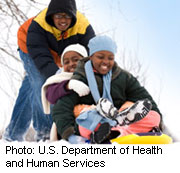- How Daily Prunes Can Influence Cholesterol and Inflammation
- When to Take B12 for Better Absorption and Energy
- Epsom Salts: Health Benefits and Uses
- See What Saffron Can Do for Sleep and Heart Health
- 6 Common Mistakes to Avoid Before Your Physical
- Can Sweating Really Help You Beat a Cold?
- Strengthening Your Relationship: Practical Strategies
- Skip Storing This Everyday Product in the Fridge Door
- Green Tea + B3 Pairing May Boost Brain Health
- Navigating Your Midlife Crisis: Embracing New Possibilities
Tips for Safe Snow Fun


Winter sports are a great way to get exercise and fresh air, but they’re not without risks.
In 2013, more than 343,000 people in the United States received medical treatment for winter sports injuries, according to the Consumer Product Safety Commission.
Skiing topped the treatment list, with 138,559 injuries. Snowboarding accounted for 95,348 accidents; sledding, more than 63,000; and ice skating, about 47,000.
“When it comes to winter sports, safety starts with knowing and practicing the rules,” Dr. Michael Cheek, a sports medicine specialist and American Academy of Orthopaedic Surgeons spokesperson, said in an academy news release.
Many skiing and snowboarding injuries can be prevented by using proper equipment and getting appropriate training, he pointed out.
“Before hitting the slopes, inexperienced participants should consider taking a lesson [or several] from a qualified instructor to help prepare for the unexpected, like learning how to fall safely,” Cheek said.
Common causes of sledding injuries include collisions at the end of sledding runs and sledding in improper positions.
General winter-sports safety advice includes going out with a partner and staying in sight of each other. Before heading outdoors, tell someone who isn’t joining you about your plans and likely location.
The academy also recommends the following:
- Check the weather before you leave, and pay attention to warnings about storms and severe temperature drops. Make adjustments for icy conditions, deep powder, wet snow and dangerous weather conditions.
- Always carry a cell phone in case of an emergency.
- Wear several layers of light, loose and water- and wind-resistant clothing, and appropriate protective gear such as goggles, helmet, gloves and padding.
- Check that all your equipment, such as ski and snowboard bindings, are in good working order.
- Be sure to warm up before your activity. Cold muscles, tendons and ligaments are at increased risk for injury.
More information
The U.S. Centers for Disease Control and Prevention offers winter health and safety tips.
Source: HealthDay
Copyright © 2026 HealthDay. All rights reserved.










